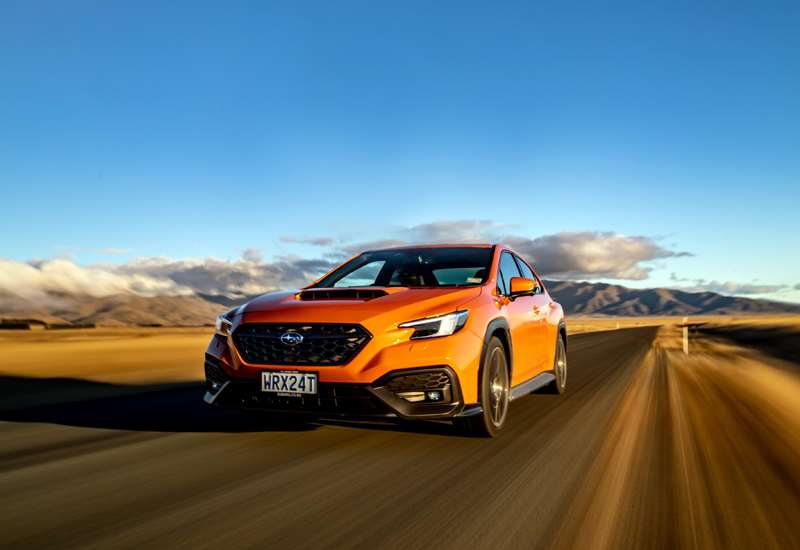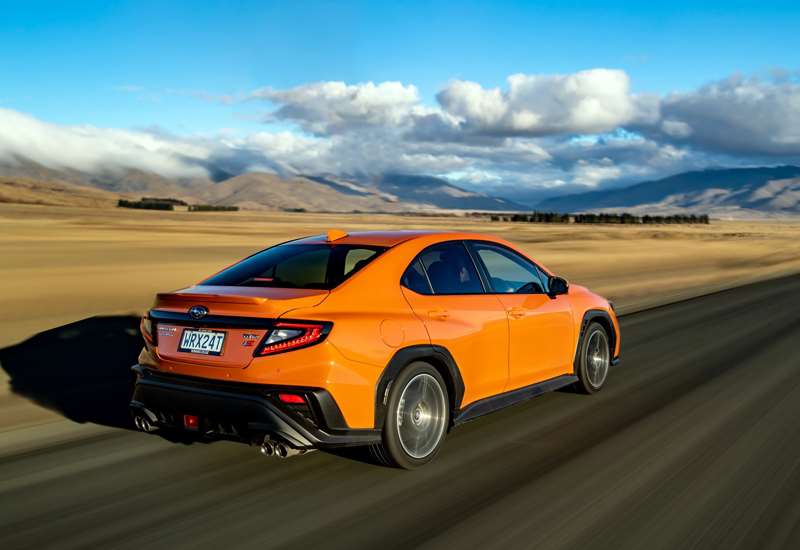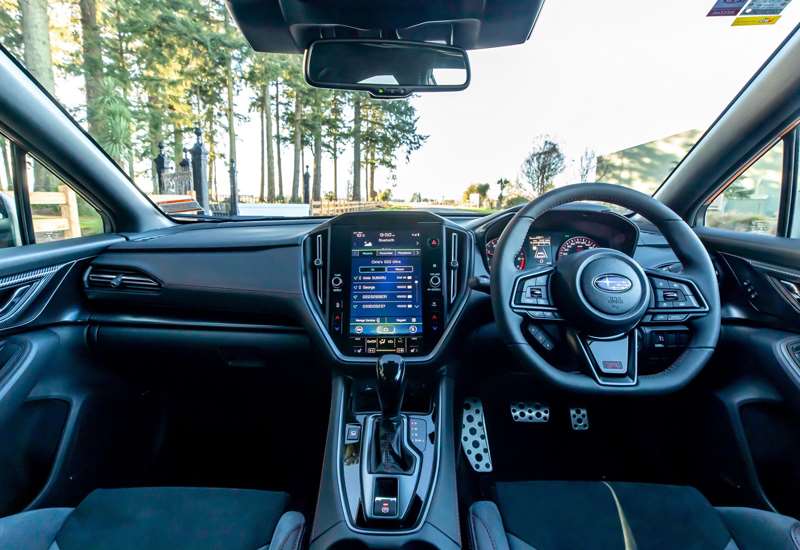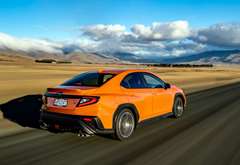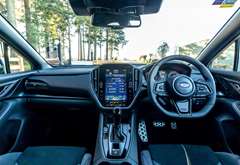The new fifth-generation WRX is likely to be the last of the line, at least as we know it. David Thomson assesses a sporty legend taking its final bow.
WHAT’S NEW?
For close to 30 years, Subaru’s WRX has been a four-wheel-drive performance car icon.
As any true-blue fan will know, its reputation was forged in the heat of world rally championship competition, in the hands of legendary drivers such as Colin McRae, Carlos Sainz, Petter Solberg, and of course our own rallying ace of those times, Possum Bourne.
The winning car on Rally New Zealand on seven occasions, it was also driven to national rally championship honours here no fewer than a dozen times. The most recent of those Kiwi title wins, earned by Ben Hunt in 2019, came a full decade after Subaru pulled the plug on its WRC involvement.
For some time then, the reputation of the WRX has been resting on its international rallying laurels.
Freed of the need to maintain a hard-core rallying connection, it has matched many of its original fans by growing up and becoming a larger, more rounded performance machine.
Given that whatever replaces the new generation WRX is likely to be hybrid (or perhaps even all-electric), this an opportune moment to reflect on the evolution of an icon.
The original WRX (or Impreza WRX, as it was back in the day) packed a 177kW power punch, with the hardcore STi variant mustering a shade over 200kW. Over time, the standard WRX lifted its power game to about 200kW, while the hottest of STi variants left the factory with as much as 235kW on tap.
Both standard and STi versions were developed for the new fifth generation WRX, but in a surprise announcement back in March, Subaru cancelled the STi. Attention would, instead, be focused on a likely electric powertrain, potentially to power an STi-equivalent in the next, sixth-generation line.
That leaves the standard WRX, in sedan or wagon guise, as the sole WRX option this time round.
Though an all-new 2.4-litre turbo engine replaces the previous 2.0-litre turbo, peak outputs barely alter, with power up marginally to 202kW, and maximum torque unchanged at 350Nm.
A six-speed manual is in the mix at entry level, but an eight-stage paddle-shift enabled CVT automatic is the default transmission choice. Power is channelled to all four wheels via Subaru’s trademark symmetrical four-wheel-drive set-up, via a conventional viscous limited-slip diff on the manual, and a variable torque distribution centre diff on the automatic. The former provides an even 50:50 front to rear torque split, while the latter bases off a nominal 45:55 rear-biased split, but ups the rear-drive bias in the vehicle’s sportier drive modes.
The new machine sits on the latest Subaru Global Platform and is slightly longer in the wheelbase and more rigid than its predecessor.
There is a new dual-pinion steering system as well as — on top-spec models — electronic suspension damping.
Pricing opens at $59,990 while the flagship auto-only 2.4T tS sedan (as tested) and GT tS wagon carry a $64,990 tag.
WHAT COMES AS STANDARD?
All WRXs feature a standard equipment list that includes an 11.6-inch central display screen with smartphone mirroring, satellite navigation with speed sign recognition, and a Harmon Kardon sound system. Dual-zone climate control, a power sunroof, power-operated front seats, and heated front and rear seats are also provided.
The manual variant misses out on some of the auto’s active safety kit, which includes adaptive radar cruise control, autonomous emergency braking, emergency steering assist, lane centering assist, blind spot monitoring, rear cross-traffic alert, and auto high beam lights.
Stepping up to the tS adds different badging inside and out, a different style of 18-inch alloy wheels, and old-school CD player, drive mode select and — in a first for the WRX — adaptive electronic damping.
WHAT’S IT LOOK LIKE?
In keeping with an expectation true enthusiasts will opt for the sedan rather than the wagon, the former boasts notably more aggressive styling tweaks including prominent side skirts that give a wider and more firmly planted stance. The sedan also runs Dunlop SP Sport Maxx 245/40 tyres, which are more performance-oriented than the wagon’s same-sized Yokohama tyres.
The test car’s hexagonal wheel arches jarred just a little for me, but the look is otherwise pretty good, with the thin, sculpted LED headlights an obvious point of difference from the old generation four WRX. The boot spoiler is quite discreet, but there are quad exhausts (never mind that the car fails to deliver the aural symphony they suggest may await).
Blue has been the WRX’s hero colour since its rallying days. Featuring a pearlescent finish that shows particularly well in bright sunlight, the test car’s solar orange paint scheme is a striking alternative.
WHAT’S IT LIKE INSIDE?
While the exterior represents a cautious evolution of a familiar WRX theme, the cabin strikes out boldly, to bring some of the higher-quality look and feel of the larger Outback to the WRX line.
The rear of the cabin is roomy enough, with the mixed suede and synthetic leather seat trims with red contrast stitching giving a nice feel.
The sunroof, big windscreen and slender A-pillars all play a part in making the front of the cabin bright and airy.
The driving position is first-rate, with a snug and supportive driver’s seat, a rake-and-reach adjustable multifunction sports steering wheel, and well-positioned alloy pedals. With conventional dials flanking a well-ordered centre digital display, the main instrument display is refreshingly uncomplicated.
On the flagship tS, both the steering wheel and instrument display feature STi rather than WRX badging; I guess when the true STi was cancelled, there was a box of STi badges that had to be used somewhere!
Mounted in portrait format, the infotainment screen dominates the dashboard area. It is generally intuitive to operate, though occasionally fiddly.
Fans of what is surely now yester-tech will be pleased to find the tS is equipped with a single disc CD player.
WHAT’S IT LIKE TO DRIVE?
Press the start button to bring the new 2.4-litre engine to life, and the initial impression of the new WRX is a trifle underwhelming; at idle, it is simply too quiet.
OK, perhaps I am being nostalgic in expecting a hint of that enticing flat-four burble that has long been the WRX signature sound, but I am surely not alone. Calling up the drive mode select screen to dial in a more aggressive engine setting makes little difference.
Setting that gripe aside, there is a lot that Subaru has got absolutely right with the dynamics and feel of this new WRX.
The so-called Subaru Performance Transmission (stop trying to fool us, it’s a CVT) isn’t my ideal for a car like this. That said, it has been very well matched to the engine, feeling in most respects like a conventional automatic, and with a reasonable amount of driver control available via the paddle shifts. It also delivers superior economy to either a manual or conventional automatic, which is an important consideration in these times of rocketing fuel prices and clean car penalty fees.
Power delivery, after a little hesitancy off the mark, is smooth and linear. Subaru claims a 0-100kmh sprint time of 6.1sec, which is decently quick, and there is ample midrange responsiveness, too.
The addition of electronic damping adds suspension adjustability to the drive mode set-up, which also alters the calibrations for the engine and gearbox, steering, all-wheel-drive and safety systems. There are four pre-set configurations to choose from — comfort, normal, sport and sport plus — along with the pick-and-mix ‘‘individual’’ option.
Even in comfort mode there is a pleasing underlying firmness to the WRX’s ride, though I found normal mode at least as good around town, and superior when used for open road cruising. Sport or sport plus are the modes of choice for more spirited driving, delivering far greater mechanical pep and sharper handling response.
With decent ride quality and noise levels well contained even on coarse chip seal, refinement takes a big step up with this fifth-generation WRX. However, the omission of that mechanical throb combined with a weightier steering set-up leaves the car lacking, a little, in feel.
Yet while it may be underdone in terms of tactile delight, the new WRX is dynamically sharp. Running in sport, or better yet sport plus mode, it accelerates strongly, is assured under braking, and grips tenaciously when pushed through twists and turns at pace.
Balance under light to moderate cornering loads is excellent and body control is excellent, even when the chassis meets severe mid-corner bumps.
The increased rear-drive bias that comes into play in sport or sport plus mode adds to its handling prowess, and when pushed into a bend at imprudent pace, the WRX’s response is simply benign, progressive understeer.
- David Thomson. Photos: Supplied
